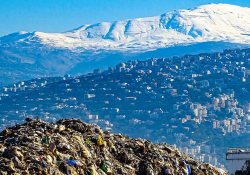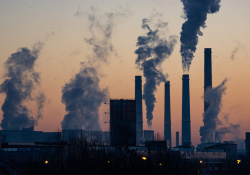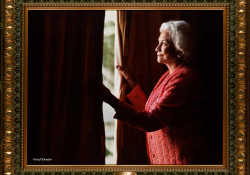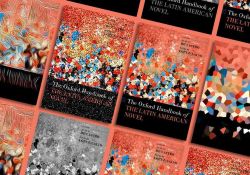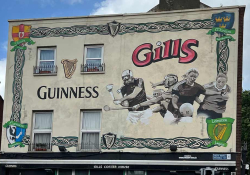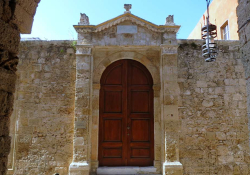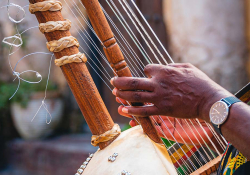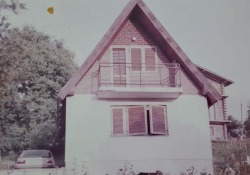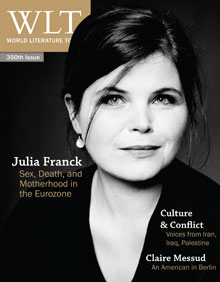An American in Berlin
Having just spent a year in Berlin, novelist Claire Messud reports on her observations in and around the city. “In Berlin,” she writes, “a sense of becoming trumps a sense of belatedness, and this makes it exciting.”
On a winter’s night last year, I crossed Berlin by subway from my sedate western corner of Charlottenburg to the hip, pitilessly unlit streets behind Hackescher Markt. I dodged the bright trams that are the arteries of former East Berlin, and clipped my way along the cobbles of Sophienstrasse toward Auguststrasse. It wasn’t late, but there was almost no one out—Berlin is often like that, even at its center: hauntingly unpeopled. I listened to my shoes upon the stone, and startled when a figure loomed in a doorway or alley. It was too early for the Romanian hookers in their preposterous Lucite platforms, recognizable for their surprising good looks and the elaborate corsets they lace over their ski jackets. I’d see them on the way home, amiably teasing the men outside the Turkish restaurant.
When I turned onto Auguststrasse, my destination halfway down the block shone dazzling in the darkness, its battered concrete yard festooned with fairy lights; and suddenly, mysteriously, people emerged from the shadows in all directions, beetling against the cold toward Clärchens Ballhaus.
This is the way with Berlin. The least lovely of European capitals, a large, ungainly, often unattractive city, Berlin reserves her charms for initiates, or at least for those willing to search.
Downstairs, Clärchens is an old-fashioned dance hall. They offer a different kind of music every night of the week—salsa, waltzes, tango—and tea dances on Sundays, attracting a diverse clientele: stout middle-aged women with rusty hair jostle against slim lads with nose piercings. It remains largely unchanged from its East Berlin self—simple, exuberant, inexpensive. Upstairs, the unchangedness of the room recalls an earlier time: the plaster is peeling, the walls cracked, the moldings half-blasted. The chandelier in the stairwell, a tangle of distorted metal, lurches from the ceiling at an improbable angle. It feels as though the party—of uniformed Nazis dancing with their young ladies—was interrupted only last night by an Allied bomb. Or again: as though the ghosts of that party have been hovering for seventy years.
That evening, the room was festooned with flowers and a candle flickered on every available surface. Each seat was filled, and additional listeners, coats still on, lounged in the doorways or against the back wall. The streets might have been barren, but behind closed doors, Clärchens was alive.
This is the way with Berlin. The least lovely of European capitals, a large, ungainly, often unattractive city, Berlin reserves her charms for initiates, or at least for those willing to search. You can wander the forbidding boulevards for weeks with no sign of intimate life; while all the time, down the alleys, in the basements, behind the walls, unexpected adventures and experiences are unfolding like exotic flowers. Everything feels hard-won in a city so burdened by ugly histories; but this makes its beauties the more beautiful, its pleasures the more pleasurable.
Since reunification—and of course famously also before—artists and writers have felt the allure of Germany’s new-old capital. It remains slightly remote from the trends of western Europe, and—rather like New Orleans in the U.S.—has its own styles and its own cults. Even now, rents are comparatively cheap, and apartments spacious; there is a profound cultural faith in, and support of, the arts, and a long-vaunted local tolerance for the eccentric (think of Christopher Isherwood). There is the rare sense of a European city, which, in spite of all that weighs upon it, is still being made, or is being made again: architecturally, to be sure, but also artistically and philosophically. In Berlin, a sense of becoming trumps a sense of belatedness, and this makes it exciting.
As an anglophone—with two paltry years of university German, remote now, never used—I found myself, during my baffling but glorious year in the city, engaging largely with particular, openly hospitable subsets of Berlin’s literary and artistic life: I fell in with expatriates, or with Germans who were themselves interested in America, or in speaking English. The city has many literary grandees—among them Nobelists Günter Grass and Herta Müller; until her recent death, Christa Wolf; Peter Schneider and Ingo Schulze, to name but a few—and, inevitably, even more interesting and original young voices, including Daniel Kehlmann, Jenny Erpenbeck, Thomas Pletzinger, Judith Hermann, and Wladimir Kaminer. Through various fellowship programs, numerous international writers reside in the city for shorter periods of time: last year, the Lebanese novelist Elias Khoury, the Swiss-based poet and memoirist Ilma Rakusa, and the British-American science writer Olivia Judson were all at the Wissenschaftskolleg zu Berlin with me; American writers John Wray, Han Ong, Todd Gitlin, and Rivka Galchen were at different times resident at the American Academy in Berlin (a beautiful waterfront compound in the western suburb of Wannsee, on the opposite side of the lake from the site of the infamous conference). Sri Lankan poet and performer Pireeni Sundaralingam arrived for the spring and summer of my stay; and Canadian writer Miriam Toews was slated for a residency in the city soon after my departure.
Then, too, there are anglophone writers living more permanently in Berlin. Susan Neiman, philosopher and author of the memoir Slow Fire (1992), has lived there on and off since the early 1980s, and for the past decade has run the Einstein Forum in Potsdam, which hosts international intellectuals for conferences and lectures. Many of their events are in English. Through the generosity of the American novelist Anna Winger, who has lived most of this new century in the city and who hosts casual gatherings that amount to impromptu salons, I encountered other literary and artistic figures, including the wonderful German cartoonist and children’s author Christoph Neimann, whose work is often featured in the New Yorker magazine.
The night at Clärchens, I was joining the literary editor of American Vogue, Megan O’Grady—who had, at that time, been living in Berlin for over a year, although she has since returned to the States—and several of her friends for a concert. She’d told me beforehand only that her friend Michael was the pianist, playing Brahms’s Piano Quintet in F Minor, so it was something of a surprise to discover, from the program, that her friend was the New York Times journalist Michael Kimmelman, and that the assembled friends included, not only the aforementioned Christoph Neimann and his mother, but Kimmelman’s fellow New York Times journalist and Berlin bureau chief Nicholas Ku-lish, at that time only recently returned from the uprising in Cairo.
There was great romance in that hushed assembly, in the bombed-out room and its wavering yolky light, in the irruption of Brahms’s passionate piece into this tableau; in the sense of history and the present in palimpsest in this place, and the apparently effortless overlap of German and English speakers, of writers and musicians, of young and old. While Berlin’s adventures may not be immediately visible, they are wonderfully accessible: I encountered surprisingly little sense of exclusivity or clique-ishness there; people of different ages or aspects mix without self-consciouness. When I attended an avant-garde opera in an all-but-abandoned warehouse only blocks from Clärchens, I was reminded of New York in the mid-1980s: the enthusiasm and energy, the slightly familiar nature of the artistic risks (we, the audience, were divided into three groups, taken into different rooms, and given three different versions of the opera: it was the performers and the musicians that came and went, rather than we ourselves), the patchy success of the endeavor—it was delicious in its low-budget freedom, in its lofty artistic ambition, and even in its failures. It wasn’t very good, as a piece of art, but it renewed my faith in the possibilities of art; and I realized how long it had been—in what has proven, over these last twenty years, a tame and homogenizing American era, so tainted by the lure of money—since I had felt that way.
This freedom—a rejection of polish, a wariness about smooth appearances—is just one part of Berlin’s attraction for writers and artists. It is a freedom dwindling, if not lost, in other major North American and European cities; and it arises, in part, from the fact that the city is poor. This is anomalous, in Germany, and seems unlikely for Germany’s capital, but Berlin is endlessly anomalous. While there are magnificent and amply funded museums and monuments, extraordinary orchestras and opera houses, there is also the complication of the city’s divided history, and before that, its thorough devastation at the end of the Second World War. There is, therefore, a plethora of cheap construction and of vast, scrubby vacant lots; a dearth of population (Berlin’s population is still smaller than it was before World War II); and a corresponding lack of rooted business and industry.
What there are, in abundance, are strange, evocative architectural spaces, some repurposed, others abandoned, all bearing stories that are waiting to be told. I never managed to climb the walls and roam the abandoned amusement park at Plänterwald in former East Berlin, although I saw enticing photographs of its derelict swan boats and fiberglass dinosaurs toppled in the brush. Nor did I take a tour of the abandoned U.S. listening station in the Grünewald, built atop the mountain known as Teufelsberg (Devil’s Moutain), an eminence created by the rubble removed from the flattened city at the end of the war, bucket by bucket, by Berlin’s famously hardy women workers. Until not long ago, as the graffiti attests, it was possible to slip into the ruin and wander around unaccompanied, but now it is carefully cordoned off and visits are controlled.
I did, however, head slightly further west, to a suburb just outside the city, to climb through the remains of the 1936 Olympic Village, the residential compound for the athletes and a Nazi showpiece. It, too, has recently been reclaimed as a historical site, but only one of the huts—the one in which the American team, and in particular Jesse Owens, slept—has been restored. For a single euro entrance fee, you can see the battered leather horse in the gymnasium, and skirt the swimming pool covered in plastic (under renovation); but above all you can wander through acres of tumbled plaster and concrete, where the stalks of abandoned streetlights stick up into the sky and rusted gates rise out of the grass, padlocked against nothing. Behind the Olympic compound, the Soviets built a massive array of apartment blocks—barracks, I was told—which were summarily abandoned at the time of reunification, and subsequently stripped by looters. Your single euro will buy you the freedom to wander here, too, in a later spookiness, an entire ghost town of gaping-eyed windows through which glimpses of once-cheerful wallpaper—lemon, turquoise, cherry—can still be seen.
A stone’s throw from the villa of the Final Solution conference, at Wannsee—now a sobering museum—stands an abandoned hospital, tucked among the trees. It can’t be long since it was closed, because there are still files upon the shelves, visible through the smeared windows, and curtains, albeit tattered, waving in the breeze. But the grass growing up through the paving stones and the chains upon the doors are testament to its disuse. The second time we went there, a posse of large white trucks was pulled up in the back courtyard, and workers were busy disgorging their contents: enormous spools of cable and giant black boxes with metal corners, the makings of a movie. In Berlin, the artists can make use of everything: the hospital had become a film set.
To the southwest of the city sits the enormous former asylum on the outskirts of Beelitz, a town known above all for its prized white asparagus. The asylum is a vast nineteenth-century construction abandoned, like the Soviet barracks, twenty years ago. Its countless elegant brick buildings—some with arcades, several built around an elegant courtyard, in the center of which stands a striking (and strikingly hideous) Soviet-era statue of a soldier holding what looks like a missile, now daubed in red paint. Hitler once stayed here. More recently, upon his removal from power, East German leader Erich Honecker retreated to its luxurious comfort. For some years afterward the haunt of a serial killer, the asylum is now home to occasional rave parties—their debris can be found scattered in the grasses and on the porches of the buildings—and to more film trucks. In this case, when we went they were preparing to film a rock video. It was a bigger project than at the hospital: we could tell by the number of portable toilets.
It may seem ironic to describe such widespread decrepitude as “fertile,” but in artistic terms, it is apt. When Jenny Erpenbeck wrote her novel Heimsuchung (Eng. Visitation, 2010), she drew upon the decline of a grand house on the outskirts of Berlin that had been in her family for decades. Susan Neiman’s evocative memoir of 1980s Berlin conveys powerfully what it felt like to be young among the ruins twenty-five years ago, Anna Winger’s more recent novel, This Must Be the Place (2008), conveys, in a different moment, the experience of the city for the newly arrived American. There is a particular vitality about Berlin—not immediately visible, perhaps, and somewhat out of the way, but genuinely inspiring. It’s a place where a renowned American journalist can perform a soaring rendition of Brahms for a packed Sunday-night audience in a bombed-out dance hall. There is room, in Berlin, for many wild flowers to grow.
Cambridge, Massachusetts
This piece is one of WLT's 2012 Pushcart Prize nominations.

